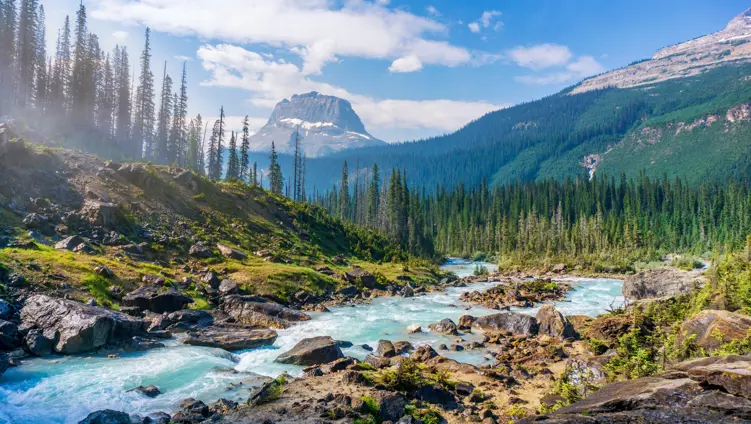Alma Wagen was one of the pioneering female mountaineers of the 20th century. In telling her story a century later, Ashli Blow pays homage to an overlooked trailblazer and reminds us of adventure's slow undercurrents.

Alma Wagen was one of the pioneering female mountaineers of the 20th century. In telling her story a century later, Ashli Blow pays homage to an overlooked trailblazer and reminds us of adventure's slow undercurrents.
At nearly 11,000ft elevation, Alma Wagen’s group was closing in on Mount Hood’s summit. The clear Oregon skies showed off the Cascades Range wrapped around them, the arena of the most recent and ambitious climbs of her life.
But hot sun brings danger in the mountains, melting snow and loosening boulders. And suddenly Alma was in mid-air, a tumbling rock having crashed into her back. Fearing a deadly fall as her body ricocheted off granite and ice, she clung to her rope in shock and indescribable pain. After years of fighting for her place in mountaineering, she had too much to live for.
Alma Wagen, Nisqually - National Parks Service and public domain
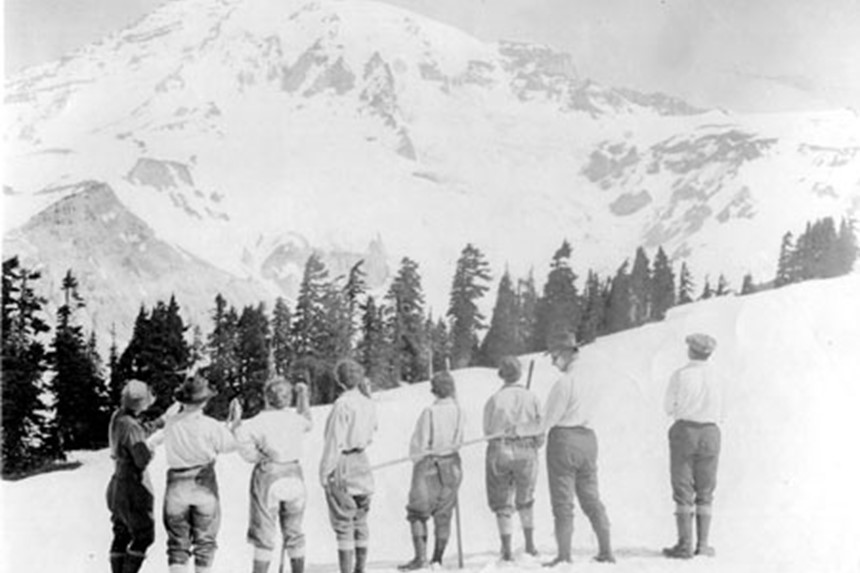
Alma started her journey where so many of us do — daydreaming at sea level.
Born in 1878, Alma grew up working on a Minnesota farm with her grandparents, surrounded by a wheat monoculture sprawling over the rolling plains.
Wire-framed windmills with squeaky turbines dotted the skyline. Her family relied on the windmills for clean water, and Alma would often climb the wire frames to grease the blades and look out into the distance.
"I wanted to get up among the clouds and to feel myself free as the birds and the air," she said in one of just two magazine interviews she ever gave. "To be able to shout my freedom as loudly as I liked without having someone point to me sadly and say, 'It is not pretty for little girls to climb windmills.'"
'I wanted to get up among the clouds and to feel myself free as the birds and the air. To be able to shout my freedom as loudly as I liked without having someone point to me sadly and say, 'It is not pretty for little girls to climb windmills.''
Alma grew up without knowing anything different. Then, after graduating college, she moved to Washington State, just thirty miles south of Seattle. It was 1904. A school, converted from a castle-like hotel that towered over the Puget Sound like a fortress, had just opened and needed teachers.
Alma taught math. She graded hard, and developed a relentless reputation among her students. But there was another matter on her mind. From the classroom window, she would stare at Mount Rainier. She told people that the mountain challenged her, and she accepted its dare.
Mount Rainier overlooking Seattle - Thom Milkovic, Unsplash
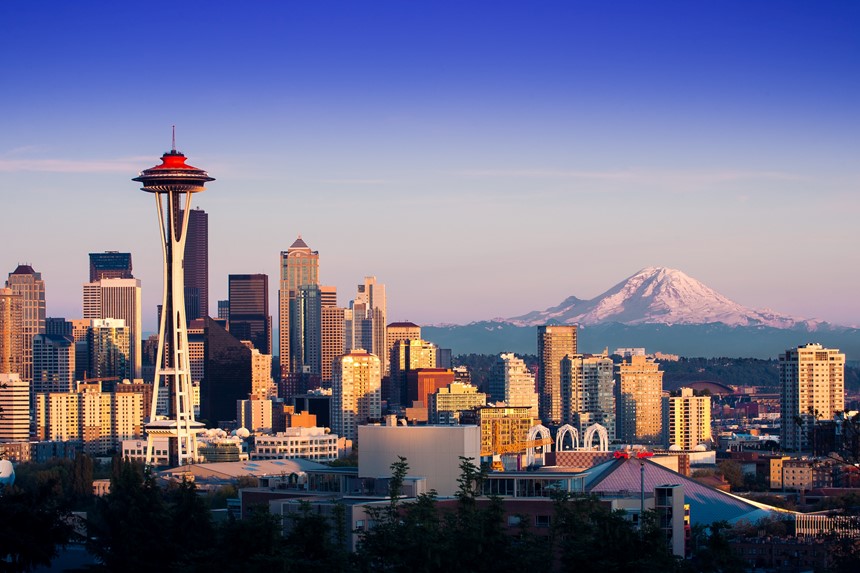
Over the summer break, Alma spent her pinched pennies on gear and set off to explore alone. She took on the Olympic Mountains on the Olympic Peninsula, where moss-covered forests meet the frigid waters of the Pacific Ocean. With little navigation or wilderness knowledge, she moved slowly and learned only through her own mistakes.
Alma scouted unmapped mountain peaks and began to expand her skill set. She experimented with lassoing ropes around rocks to aid her climbing, and relied on her iron-tipped wooden alpenstock for stability on slopes. She recorded notes of her summit coordinates.
"It was like the opening of a new life to me," she told a journalist for the now-folded American Magazine. "At last, I had found the time and the place to climb, and I learned everything I possibly could. Then I looked for new fields to conquer, and found my life's work. I wanted to teach other women the joy of climbing."
Her endeavor to become one of the first women mountaineering guides would be nearly a decade-long pursuit. But the pace would not be set not by her physical bounds.
The Olympic National Park - Jachan Devol, Unsplash
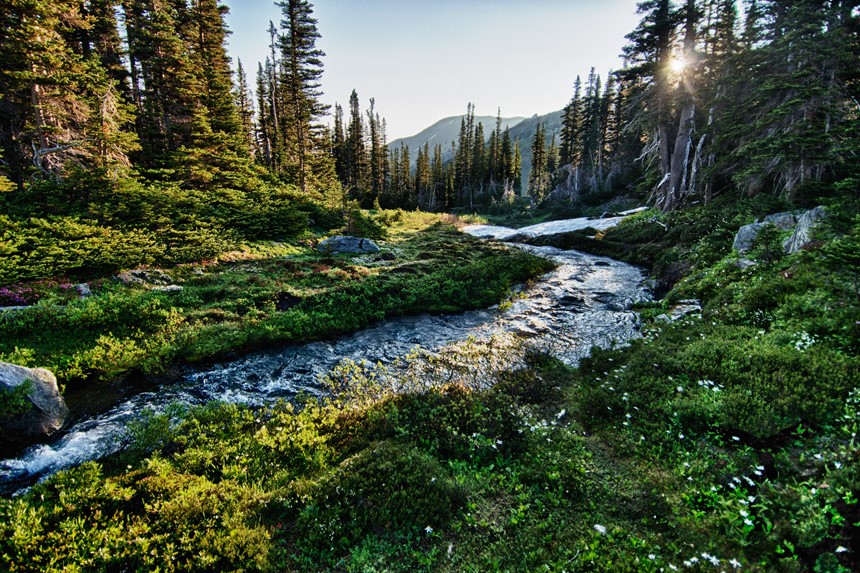
At the time, women accounted for about one third of people summiting mountains in the American West, writes Polly Welts Kaufman in National Parks and the Woman’s Voice. Remarkably, this is proportionally the same number of women climbing outdoors in the United States today, according to The American Alpine Club.
Despite their clear capabilities, many still questioned women who sought an adventure-driven life. And while female mountaineers started to grow in numbers, they still relied heavily on men to share navigational and technical information. The Canadian Alpine Journal published a disparaging piece in 1909, written by female mountaineer Mary Crawford, about such knowledge sharing. It read:
"She spends a night under the canvas and feels pangs of hunger to which she has long been a stranger ... Nervous about the experiences to come? Perhaps. But there are guides, men of experience, whom she has to only obey, and who will show her the right thing to do."
The narrative about the incapability of women was so deeply ingrained that women themselves internalised it. Sexism, and a myriad of issues that intersected with it, placed an extra burden on mountaineers like Alma. Progressing was like trekking an exhausting scree slope, without firm footholds, to reach a craggy peak.
The turn-of-the-century discourse about women in the outdoors underscores the classist, exclusionary and racist culture that American recreation was founded on, as examined in The Rise of the American Conservation Movement: Power Privilege and Environmental Protection by Doreceta E. Taylor. Crawford's piece specifically perpetuated the stereotype that all women of this generation were delicate and wealthy. This privileged, white perception ignored other women's experiences of walking in nature, often not for the sake of adventure, but because their lives depended on it. These were the lives of the Indigenous women in forced displacement, Black women escaping slavery and poor working women on the frontier.
'This privileged, white perception ignored other women's experiences of walking in nature, often not for the sake of adventure, but because their lives depended on it. These were the lives of the Indigenous women in forced displacement, Black women escaping slavery and poor working women on the frontier.'
In this context, in 1913, Alma joined the Seattle-based club The Mountaineers, founded largely by women in 1906 to learn and influence others.
Here Alma started to make a name for herself in the Pacific Northwest mountaineering community, proudly taking the title of windmill girl with her as she climbed mountain ranges from Alaska to Montana- always identifiable on the trail by the Tyrolean hat she wore adorned with a pheasant feather.
In 1915, she made it to Paradise, the 6,000ft-elevation starting point to the ascent of Mount Rainier. Wildflower-carpeted meadows and glacier-fed streams greeted her. She was so skilled by this time that not only did she summit, but she also circumvented it in a backpacking trip that same summer.
While Alma still had hopes of becoming a mountain guide, opportunities in national parks were still largely handed to men. And, according to Kaufman, where women were starting to work in national parks, they were often given menial roles. At Mount Rainier National Park, for example, a skilled outdoorswoman named Helen Wilson became a Park Ranger. However, she was assigned the menial task of recording the number of cars that entered the park. After putting in long hours at the entrance booth, Wilson advocated for herself, and the Park Superintendent finally put her on patrol in the alpine meadows.
Exploring Chinook Pass, in the Pacific Northwest, today - Ashli Blow
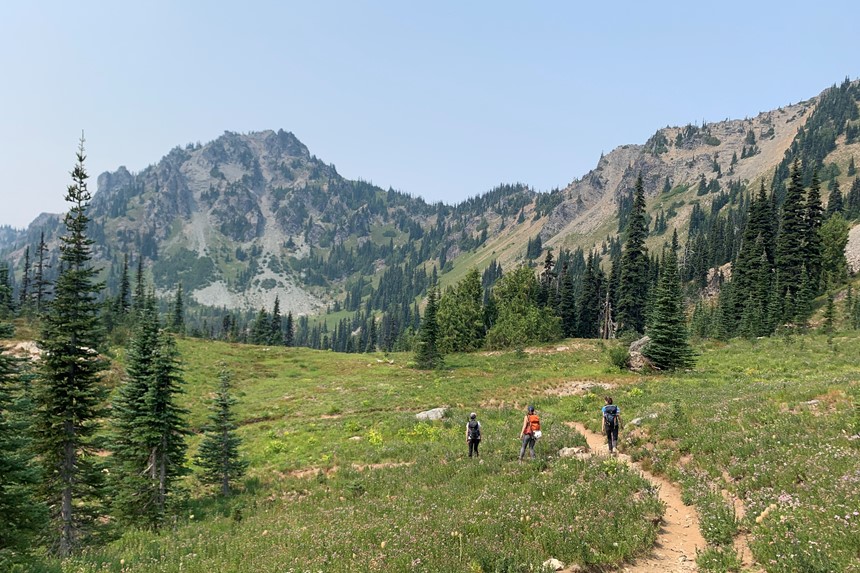
Exploring Baker Snoqualmie National Forest, in the Pacific Northwest, today - Ashli Blow

Alma knew she had to keep pushing her boundaries. In one of the most ambitious trips of her life, Alma and a group of fellow mountaineers embarked on a dusty 125-mile backpack from Mount St. Helens to Mount Adams, summiting both in August 1917. When Alma arrived at the starting point, Spirit Lake, she looked through emerald branches to see the glistening dome of St. Helens above her.
“(The trees) led through a beautiful forest,” she wrote in a travelogue for The Moutnaineers, “which gradually frayed out in the scatter pines and stunted trees as we reached the base of the mountain. We marched up the zig-zag trail, over snow slopes, under the glaring sun. Then having reached the highest point of Helens, we forgot the difficulties it took to get here. In silent thoughtfulness we were lost for some moments to all else save the far-reaching spaces. Scanning the horizon for familiar landmarks we found Mount Rainier with his accompaniment of lesser peaks and ranges in the north."
Left: Alma Wagen with fellow guide Jake Shaidell, Mount Rainier National Park, 1919 - University of Washington Libraries, Special Collections, UW14003
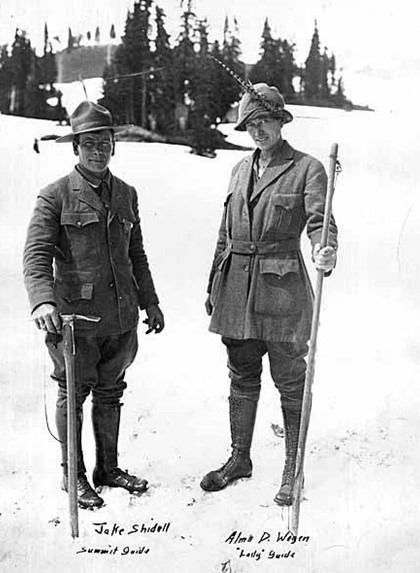

Just a couple of weeks later, while climbing Mount Hood, the falling boulder struck her lower back. Her determination saved her from death, but her body was devastated. Her climbing group believed she either fractured or broken her hip. They wrapped her in sweaters and coats, and carried her for eight hours through the snowfields to safety.
In part, Alma regained her strength through pure play at Paradise. She also deliberately wandered at Mount Rainier. She observed glaciers and their crevasses for climbing. The glacial rivers were filled with dense ice tall and strong enough to serve as a ridgeline. When rivers of glacier meltwater carved ice caves in the summer, Alma would stand in chilly, otherworldly arches. She mapped routes and began leading hikes on Emmons, the eight-square-mile glacier that led to her first Rainier summit, and the largest glacier in the continental United States.
Alma finally applied to be a guide at Mount Rainier National Park later that year, 1918. Her acceptance was facilitated by the First World War, which caused male labour shortages that forced men to acknowledge the capability of women in the workforces across industries and the United States. National parks were no exception. Nevertheless, the Guide Manager at Rainier could not dismiss Alma’s undeniable technical prowess and understanding of the mountain. “Miss Wagen is capable, resourceful, has nerve, judgement, discretion,” manager Joe Hazard told the now-folded Sunset Magazine. “Forget that she is a young woman, highly educated with a most charming personality. Miss Wagen is holding her place on Mount Rainier for the reasons that she is a superlatively good guide. No more is to be said.”
While the Park Service required guides to strictly adhere to government-issued uniforms, they weren’t designed for women. Alma took the smallest she could find and tied the belt of her jacket tight. She kept the feather in her hat. In a series of photographs, she stands alongside her male counterparts, “Lady Guide” scribbled beneath her.
Mount Rainier climbing guides at Paradise Inn, 1919, including Alma Wagen the "Lady Guide" - University of Washington Libraries, Special Collections, UW14003
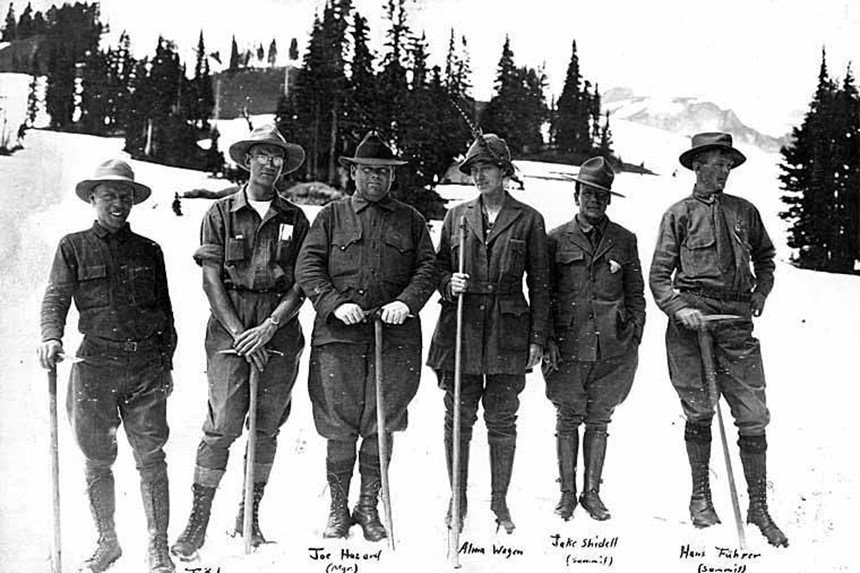
Alma's experience transcended her gender, but she used her womanhood to make space for others. At the helm, she passed mountaineering and wilderness skills along to others with a firm belief that anyone who wanted to climb could do so. Although she carried harmful privileges and biases of her whiteness, Alma was among those who had to fight against the image of wealthy, female fragility.
"Up on top of the world, one learns what people really are," she said. "It's really remarkable what a tremendous reserve not only of courage, but of strength and endurance there is in most of us. Scores of men and women give up just because they think they can go no further. Let them apply the spur to themselves, and they can make it if the body is sound ... There is no better fun in the world to know the wonderful exhilaration of viewing range on range of mountain peaks that rise in tinted ranks above the sky."
'Up on top of the world, one learns what people really are.'
Hood Meadows today - Ashli Blow

Nearly 100 years after Alma’s tenure as a mountain guide the ecological world she saw was vastly different to today’s. Now, on Emmons Glacier, mountaineers walk along the White River, through a valley of battered rocks and new forest growth where sheets of ice once stood. The glacier has lost half a square mile in the last century, according to the National Park Service's report, Change in Glacial Extent at Mount Rainier. The once slow-moving glacial river now collapses and melts into the ground in its warm retreat.
As alpine landscapes melt, adversity still locks people out from experiencing elements of a disappearing world. Wealthy and educated women continue to find adventurous spaces that are still male-dominated. Meanwhile, the LGBTQIA+ community, and women and non-binary individuals of colour, size, low-income and disability have created their own safe and reliable avenues to get outside. Outside of these avenues it becomes challenging to gain the technical skills required to summit challenging peaks. Most guides and classes today are expensive, time-consuming and place extreme physical expectations on their students. It is exclusionary to people who are not on pace set by people who historically have had the time and access for mountain training.
That’s why so many of us are still on our own slow ascents. Despite all the limitations placed on us, we make up the ground in tenacity.
Acknowledgments
Recreation in America takes place on the unseeded, ancestral land of Indigenous people. Seattle is on Duwamish land. The Olympic Peninsula is on S'Klallam, Skokomish, Quileute, Queets, Quinault, and Chehalis land. Mount Tahoma still bears its colonial name, Rainier; it stands on Nisqually and Puyallup land. Mount St. Helens, Adams and Hood and the trails around them stand on land of Cowlitz, Clackamas, Molalla and Confederated Tribes of Siletz Indians.
Beyond the sources cited, historical references used in this piece come from the Government Service. Sociological references come from the books Climbing in North America by Chris Jones and National Park Service Uniforms: In Search of an Identity by R. Bryce Workman.


